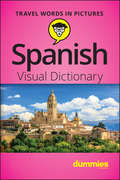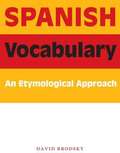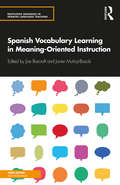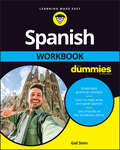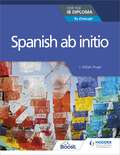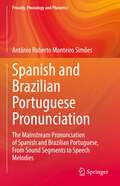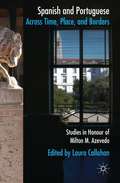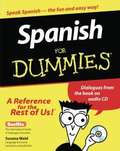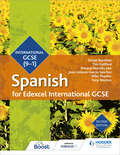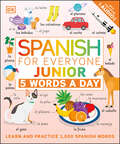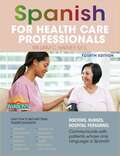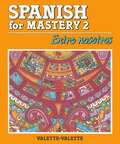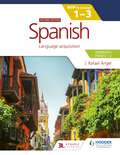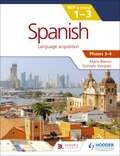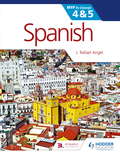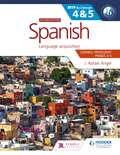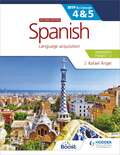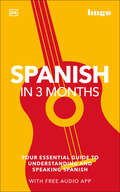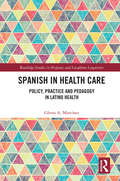- Table View
- List View
Spanish Visual Dictionary For Dummies
by Consumer DummiesSpanish Visual Dictionary Learn Spanish vocabulary faster!It’s a fact—seeing something helps you remember it. This handy guide helps you build your Spanish vocabulary with full-color pictures illustrating every term. You’ll be able to communicate with native speakers faster as you learn and remember more words and their meanings. The book is organized by themes such as transportation, accommodations, restaurants and eating, sports, emergencies, and shopping, making it especially useful for travelers. Boost your learning speed and get talking in Spanish today!InsideTransportation terminologyGetting around a cityRestaurants and food ordersHandling an emergency
Spanish Vocabulary
by David BrodskyUnlike other vocabulary guides that require the rote memorization of literally thousands of words, this book starts from the premise that using the etymological connections between Spanish and English words--their common derivations from Latin, Greek, and other languages--is the most effective way to acquire and remember vocabulary. This approach is suitable for beginners as well as for advanced students. Teachers of the language will also find much material that can be used to help motivate their students to acquire, and retain, Spanish vocabulary. Spanish Vocabulary is divided into four parts and four annexes:Part I provides background material on the origins of Spanish and begins the process of presenting Spanish vocabulary. Part II presents "classical" Spanish vocabulary--words whose form (in both Spanish and English) is nearly unchanged from Latin and Greek. Part III deals with "popular" Spanish vocabulary, which underwent significant changes in form (and often meaning) during the evolution from Latin to Spanish. A number of linguistic patterns are identified that will help learners recognize and remember new vocabulary. Part IV treats a wide range of themes, including words of Germanic and Arabic origin, numbers, time, food and animals, the family, the body, and politics. Annex A: Principal exceptions to the "Simplified Gender Rule"Annex B: 700 words whose relations, if any, to English words are not immediately obviousAnnex C: -cer verbs and related wordsAnnex D: 4,500 additional words, either individually or in groups, with English correspondences
Spanish Vocabulary Learning in Meaning-Oriented Instruction (Routledge Advances in Spanish Language Teaching)
by Javier Muñoz-Basols Joe BarcroftSpanish Vocabulary Learning in Meaning-Oriented Instruction is the first comprehensive overview of current research and instructional practices into Spanish vocabulary acquisition through the lens of Meaning-Oriented Instruction (MOI). Key features: • a breadth of topics including language variation, input, tasks and processing specificity, incidental learning, idiomatic language, lexicographic perspectives, lexicosemantic representation, vocabulary testing, and receptive and productive vocabulary; • a combination of theory and practical guidance highlighting pedagogical best practices in the teaching of vocabulary; • guidance on the difficulties teachers face when teaching vocabulary in the classroom; • clear explanations with plenty of examples and useful references; • tasks and activities that help teachers move from a traditional curricular approach to a more innovative and engaging one focused on communicating, completing tasks, and learning content. Written by an international cohort of scholars in a succinct and accessible manner, Spanish Vocabulary Learning in Meaning-Oriented Instruction is an essential resource for teachers of Spanish at all levels. It is also an excellent reference book for researchers and both undergraduate and graduate students interested in Spanish vocabulary acquisition.
Spanish Workbook For Dummies
by Gail Stein¿Habla español? Improve your Spanish with Dummies Spanish Workbook For Dummies is full of clear explanations and hundreds of practice activities for beginning Spanish learners. You'll learn how to express yourself, ask questions, talk about the past, and construct simple sentences—en español. As you work through the book, complete practice exercises, get lots of writing opportunities, and have tons of fun. Then check your work, with answers and explanations at the end of every chapter. Plus, you'll have access to handy verb charts, a thematic vocabulary list, and mini-dictionaries, right inside this very book. Learn the fundamentals of Spanish with integrated grammar that advances as you go Work through practice exercises and activities as you read through each chapter Improve and activate your Spanish with explanations of each workbook answer Avoid common mistakes made by Spanish learners and get ready to travel, chat with friends, or interact with colleagues This friendly Dummies workbook is perfect for beginners of all ages. If you're looking to get started with Spanish, step right in—we've got the practice, practice, practice you need to succeed.
Spanish ab initio for the IB Diploma: by Concept
by J. Rafael AngelEnsure that the needs of all IB Students are met with this comprehensive and flexible Student Book, written specifically for the updated Spanish ab initio course. - Communicate confidently by exploring the five prescribed themes through authentic texts and skills practice at the right level, delivered in clear learning pathways. - Produce coherent written texts and deliver proficient presentations with grammar and vocabulary introduced in context and in relation to appropriate spoken and written registers. - Improve receptive skills with authentic written texts, audio recordings spoken at a natural pace, and carefully crafted reading and listening tasks.- Promote global citizenship, intercultural understanding and an appreciation of Hispanic cultures through a wide range of text types and cultural material from around the world. - Deliver effective practice with a range of structured tasks within each unit that build reading, listening, speaking and writing skills.- Establish meaningful links to TOK and CAS, and identify learner profile attributes in action.The audio for the Student Book is FREE to download from www.hoddereducation.com/ibextrasAnswers to the Student Book are included in the accompanying subscription based, Teaching and Learning Resources
Spanish ab initio for the IB Diploma: by Concept
by J. Rafael AngelEnsure that the needs of all IB Students are met with this comprehensive and flexible Student Book, written specifically for the updated Spanish ab initio course. - Communicate confidently by exploring the five prescribed themes through authentic texts and skills practice at the right level, delivered in clear learning pathways. - Produce coherent written texts and deliver proficient presentations with grammar and vocabulary introduced in context and in relation to appropriate spoken and written registers. - Improve receptive skills with authentic written texts, audio recordings spoken at a natural pace, and carefully crafted reading and listening tasks.- Promote global citizenship, intercultural understanding and an appreciation of Hispanic cultures through a wide range of text types and cultural material from around the world. - Deliver effective practice with a range of structured tasks within each unit that build reading, listening, speaking and writing skills.- Establish meaningful links to TOK and CAS, and identify learner profile attributes in action.The audio for the Student Book is FREE to download from www.hoddereducation.com/ibextrasAnswers to the Student Book are included in the accompanying subscription based, Teaching and Learning Resources
Spanish and Brazilian Portuguese Pronunciation: The Mainstream Pronunciation of Spanish and Brazilian Portuguese, From Sound Segments to Speech Melodies (Prosody, Phonology and Phonetics)
by Antônio Roberto SimõesThis book contrasts variations in Spanish and Brazilian Portuguese pronunciation, using as a reference for discussion the mainstream careful speech of news anchors at the national level or the equivalent type of speech: a well-educated style that nonetheless sounds natural. Pursuing an innovative approach, the book uses this view of language as a cornerstone to describe and discuss other social and regional variants relative to that speaking register. It is aimed at speakers of Spanish interested in learning Portuguese and speakers of Portuguese who want to learn Spanish, as well as language specialists interested in bilingualism, heritage languages, in the teaching of typologically similar languages in contrast, and readers with interest in Phonetics and Phonology. The book employs a variety of innovative approaches, especially the reinterpretation of some of the traditional concept in Phonetics, and the use of speech prosodies and speech melodies, a user-friendly strategy to describe speech prosody in languages and speech melody in music through musical notation.
Spanish and Portuguese across Time, Place, and Borders
by Laura CallahanSpanish and Portuguese Across Time covers a diverse range of topics with a common focus, on the dynamic nature of languages and the social forces that shape them across time, place, and borders, and demonstrates how linguistic principles can offer productive angles to the study of literature.
Spanish at Work
by Nuria Lorenzo-DusSpanish at Work is the first book examining the discourse practices of institutions in the Spanish-speaking world. It focuses on three 'umbrella' institutions (the mass-media, politics and the workplace), each of which are explored through a discrete theme. Within the mass media, chapters focus on the relationship between language and identity; within the political domain, persuasion and performance are investigated; and within the workplace, chapters explore the negotiation of interpersonal relations in work-related activity types. Spanish at Work delves into a varied selection of countries and settings in which Spanish is spoken variously as one of several official languages, as the official language, as a 'minority' language, and even as a second language or one of a number of other languages. Spanish at Work will be essential reading for upper-level undergraduates and graduates in Spanish linguistics and discourse analysis, as well as for practitioners in these fields.
Spanish for Dummies
by Susana Wald Juergen LorenzSpanish For Dummies is the fun and easy way to learn Spanish quickly and painlessly! Written by the experts at the renowned Berlitz school, this hands-on resource shows you the ins and outs of the Spanish language and culture, acting as both a guidebook and a reference. Soon you will have all the tools you need to:<P>* Master the nuts and bolts of grammar<P>* Greet others and introduce yourself<P>* Get to know people with small talk<P>* Order in restaurants<P>* Shop anywhere<P>* Go out on the town<P>* Enjoy yourself with local recreation<P>* Have a conversation on the phone<P>* Work in an office and around the house<P>* Ask for directions<P>* Check in and out of a hotel<P>* Use transportation<P>* Call for help in an emergency<P>This guide features ways to start speaking Spanish quickly, as well as common expressions, important holidays, and phrases that'll make you sound fluent. Complete with an audio CD that allows you to hear actual Spanish conversations by native Spanish speakers, Spanish for Dummies is the ultimate guide for speaking Spanish quick and easy!<P>* Note: CD-ROM/DVD and other supplementary materials are not included as part of eBook file.
Spanish for Edexcel International GCSE, Second Edition
by Mónica Morcillo Laiz Simon Barefoot Timothy GuilfordThis Student Book provides a grammar-led approach with extensive exam preparation to develop independent, culturally aware students of Spanish, ready for the exam.This book is endorsed by Cambridge International Examinations for the latest IGCSE® (0525) and International Level 1/Level 2 Certificate (0677) syllabuses. Extensive use of Spanish reflects the style of the exams and, with specific advice and practice, it helps students use the acquired skills to their best ability. Topics on Spanish-speaking cultures are integrated throughout to ensure students gain the cultural awareness that is at the heart of this qualification. The book provides up-to-date content following a clear sequencing of topics designed specifically for teaching Spanish at this level. It is designed to develop spontaneous, confident linguists who are able to progress to further study of Spanish.
Spanish for Everyone Junior: 5 Words a Day (DK 5-Words a Day)
by DKHelp your child master Spanish vocabulary — five words at a time! Learn 1,000 Spanish words over the course of a year with this Spanish workbook for beginners! It&’s an essential vocabulary builder for young children who are starting to learn their first Spanish words.Discover the perfect introduction to Spanish for children ages 6-9. It&’s the ultimate Spanish lesson for kids! It includes: • Beautifully illustrated scenes that teach and test five words at a time. New vocabulary is practiced again at the end of each week in two pages of exercises. • Clever flaps on the jacket that cover the scene so your child can practice what they have just learned. • Uses the effective rote-learning method to teach new vocabulary. • Teaches a range of nouns and verbs that are useful in everyday life. Audio is available online and via a handy app to help with pronunciation. This unique Spanish teaching guide contains everything your child needs to acquire a firm grasp of the Spanish language in a fun and interactive way! Each week, 20 new words are presented over four days, and on the fifth day, your child can practice the words they have just learned. This will help them build up a vocabulary of more than 1,000 Spanish words over the course of a year! From animals and sports to colors and plants, Spanish for Everyone Junior teaches a mix of nouns and verbs through stunning illustrations with each new word clearly labeled. This encourages young learners to memorize the words before covering them with the cleverly designed flaps and testing their new knowledge. Accompanying audio means that children are also able to practice their Spanish pronunciation as many times as they want.More titles in the series to exploreThe colorful, clear and comprehensive 5 Words a Day series from DK lays the foundations for your child's journey in learning a foreign language, at school or home. Look out for other workbooks in the series! Help your child learn, practice and understand 1,000 French words in French for Everyone Junior: 5 Words a Day.
Spanish for Health Care Professionals, 4th ed.
by William C. HarveyThis book is designed to help doctors, nurses, and medical assistants communicate in Spanish with Latino patients and their families who have little or no command of English. Fully updated text includes the addition of vocabulary for informing families about patients' medical care or death; instructing patients on how to navigate online forms; a sample disclosure and consent form in both Spanish and English; and a new section on working with medical interpreters. Every Spanish word in the book is followed by its phonetic pronunciation. The book also provides easy-to-follow tips on understanding colloquial spoken Spanish. Author William Harvey concentrates on words and phrases likely to be used in a medical setting. True-to-life dialogues dramatize situations pertaining to pregnancy, broken bones, pediatric care, heart and lung diseases, pharmacy prescriptions, and much more.
Spanish for Mastery: Level Two: Entre Nosotros
by Jean-Paul Valette Rebecca M. ValetteSpanish for Mastery: Level Two: Entre Nosotros
Spanish for the IB MYP 1-3 (Emergent/Phases 1-2) (Emergent/Phases 1-2) (Emergent/Phases 1-2) (Emergent/Phases 1-2): MYP by Concept Second edition: By Concept
by J. Rafael AngelDevelop your skills to become an inquiring learner; ensure you navigate the MYP framework with confidence using a concept-driven and assessment-focused approach to Spanish, presented in global contexts.- Develop conceptual understanding with key MYP concepts and related concepts at the heart of each chapter. - Learn by asking questions for a statement of inquiry in each chapter. - Prepare for every aspect of assessment using support and tasks designed by experienced educators.- Understand how to extend your learning through research projects and interdisciplinary opportunities.- Think internationally with chapters and concepts set in global contexts.
Spanish for the IB MYP 1-3 (Emergent/Phases 1-2) (Emergent/Phases 1-2) (Emergent/Phases 1-2) (Emergent/Phases 1-2): MYP by Concept Second edition: By Concept
by J. Rafael AngelDevelop your skills to become an inquiring learner; ensure you navigate the MYP framework with confidence using a concept-driven and assessment-focused approach to Spanish, presented in global contexts.- Develop conceptual understanding with key MYP concepts and related concepts at the heart of each chapter. - Learn by asking questions for a statement of inquiry in each chapter. - Prepare for every aspect of assessment using support and tasks designed by experienced educators.- Understand how to extend your learning through research projects and interdisciplinary opportunities.- Think internationally with chapters and concepts set in global contexts.
Spanish for the IB MYP 1-3 Phases 3-4: by Concept
by Gonzalo Vázquez María BlancoA concept-driven and assessment-focused approach to Spanish teaching and learning.- Approaches each chapter with statements of inquiry framed by key and related concepts, set in a global context- Supports every aspect of assessment using tasks designed by an experienced MYP educator- Differentiates and extends learning with research projects and interdisciplinary opportunities- Applies global contexts in meaningful ways to offer an MYP Spanish programme with an internationally-minded perspective
Spanish for the IB MYP 1-3 Phases 3-4: by Concept
by Gonzalo Vázquez María BlancoA concept-driven and assessment-focused approach to Spanish teaching and learning.- Approaches each chapter with statements of inquiry framed by key and related concepts, set in a global context- Supports every aspect of assessment using tasks designed by an experienced MYP educator- Differentiates and extends learning with research projects and interdisciplinary opportunities- Applies global contexts in meaningful ways to offer an MYP Spanish programme with an internationally-minded perspective
Spanish for the IB MYP 4 & 5
by J. Rafael AngelWe are working with the IB to gain endorsement for the MYP by Concept series.Drive meaningful inquiry for the new framework through a unique concept driven narrative.- Supports every aspect of assessment with opportunities that use the criteria- Gives you easy ways to differentiate and extend learning- Provides a meaningful approach by integrating the inquiry statement in a global context- Develops critical-thinking skills with activities and summative sections rooted in the ATL frameworkAlso coming soon are Teaching and Learning Resources and eTextbooks via Dynamic Learning, our complete digital solution.
Spanish for the IB MYP 4&5 (Capable-Proficient/Phases 3-4, 5-6) (Capable-Proficient/Phases 3-4, 5-6) (Capable-Proficient/Phases 3-4, 5-6) (Capable-Proficient/Phases 3-4, 5-6) (Capable-Proficient/Phases 3-4, 5-6) (Capable-Proficient/Phases 3-4, 5-6) (Capable-Proficient/Phases 3-4, 5-6) (Capable-Proficient/Phases 3-4, 5-6): MYP by Concept Second edition: By Concept
by J. Rafael AngelDevelop your skills to become an inquiring learner; ensure you navigate the MYP framework with confidence using a concept-driven and assessment-focused approach to Spanish, presented in global contexts.- Develop conceptual understanding with key MYP concepts and related concepts at the heart of each chapter. - Learn by asking questions for a statement of inquiry in each chapter. - Prepare for every aspect of assessment using support and tasks designed by experienced educators.- Understand how to extend your learning through research projects and interdisciplinary opportunities.- Think internationally with chapters and concepts set in global contexts.
Spanish for the IB MYP 4&5 (Capable-Proficient/Phases 3-4, 5-6) (Capable-Proficient/Phases 3-4, 5-6) (Capable-Proficient/Phases 3-4, 5-6) (Capable-Proficient/Phases 3-4, 5-6): MYP by Concept Second Edition: By Concept
by J. Rafael AngelDevelop your skills to become an inquiring learner; ensure you navigate the MYP framework with confidence using a concept-driven and assessment-focused approach to Spanish, presented in global contexts.- Develop conceptual understanding with key MYP concepts and related concepts at the heart of each chapter. - Learn by asking questions for a statement of inquiry in each chapter. - Prepare for every aspect of assessment using support and tasks designed by experienced educators.- Understand how to extend your learning through research projects and interdisciplinary opportunities.- Think internationally with chapters and concepts set in global contexts.
Spanish for the IB MYP 4&5 (Emergent/Phases 1-2) (Emergent/Phases 1-2) (Emergent/Phases 1-2) (Emergent/Phases 1-2) (Emergent/Phases 1-2) (Emergent/Phases 1-2) (Emergent/Phases 1-2) (Emergent/Phases 1-2): MYP by Concept Second edition: By Concept
by J. Rafael AngelDevelop your skills to become an inquiring learner; ensure you navigate the MYP framework with confidence using a concept-driven and assessment-focused approach to Spanish, presented in global contexts.- Develop conceptual understanding with key MYP concepts and related concepts at the heart of each chapter. - Learn by asking questions for a statement of inquiry in each chapter. - Prepare for every aspect of assessment using support and tasks designed by experienced educators.- Understand how to extend your learning through research projects and interdisciplinary opportunities.- Think internationally with chapters and concepts set in global contexts.
Spanish for the IB MYP 4&5 (Emergent/Phases 1-2) (Emergent/Phases 1-2) (Emergent/Phases 1-2) (Emergent/Phases 1-2) (Emergent/Phases 1-2) (Emergent/Phases 1-2) (Emergent/Phases 1-2) (Emergent/Phases 1-2): MYP by Concept Second edition: By Concept
by J. Rafael AngelDevelop your skills to become an inquiring learner; ensure you navigate the MYP framework with confidence using a concept-driven and assessment-focused approach to (insert subject), presented in global contexts.- Develop conceptual understanding with key MYP concepts and related concepts at the heart of each chapter. - Learn by asking questions for a statement of inquiry in each chapter. - Prepare for every aspect of assessment using support and tasks designed by experienced educators.- Understand how to extend your learning through research projects and interdisciplinary opportunities.- Think internationally with chapters and concepts set in global contexts.
Spanish in 3 Months with Free Audio App: Your Essential Guide to Understanding and Speaking Spanish (DK Hugo in 3 Months Language Learning Courses)
by DKLearn to speak, read and write Spanish fluently in just 3 months, and adopt an awe-inspiring craft!This educational language guide into the Spanish language has a newly updatedlook and an accompanying audio app that will get you speaking, reading and writing in Spanish easily and promptly. Inside the pages of this Spanish language book, you&’ll find: • &“Imitated pronunciation&” sections that make unfamiliar Spanish sounds less daunting to English learners • Word lists, key phrases and model sentences that build vocabulary • Three self-assessment sections that allow the learner to engage with their own learning, and exercises follow each grammar lesson, reinforcing what has just been taught • Includes two mini bilingual dictionaries, meaning you can check words in both English and Spanish Adopting a new language is made exciting and super easy with the latest edition of this classic self-study course providing all the resources that you need to converse, read and write in Spanish. If you&’re a complete beginner or simply want to refresh your knowledge, Hugo: Spanish in Three Months will have you speaking Spanish fluently in as little as just 12 weeks.This carefully structured grammar-based course contains 12 weekly chapters filled with informative lessons on the key grammatical structures and presents a range of useful vocabulary, along with easy-to-follow exercises to encourage your learning. You are taught approximately 4,000 words in a spoken, written and listening format, in addition to a helpful written &“imitated pronunciation&” guide. It replaces Spanish sounds with English syllables you&’re already familiar with, so you can perfect your pronunciation at home or on the go.Whether you&’re learning a new language for work, a future vacation or as a hobby, the Hugo language course series is the perfect place to start. Learn languages like French, Dutch, German or Portuguese in only 12 weeks! Each course includes an audio app to help with understanding and pronunciation. Language learning has never been so easy!
Spanish in Health Care: Policy, Practice and Pedagogy in Latino Health (Routledge Studies in Hispanic and Lusophone Linguistics)
by Glenn A. MartínezSpanish in Health Care fills an important gap by offering a panoramic overview of the research on Spanish in health settings that is emerging from a variety of disciplines. Synthesizing research from diverse disciplines such as sociolinguistics, discourse analysis, health services research, behavioral health research, health policy and administration, and social epidemiology, the volume offers a uniquely unified approach to the subject of Spanish in healthcare. This volume will be of interest to researchers in Spanish linguistics, sociolinguistics, health communication, and languages for specific purposes.
